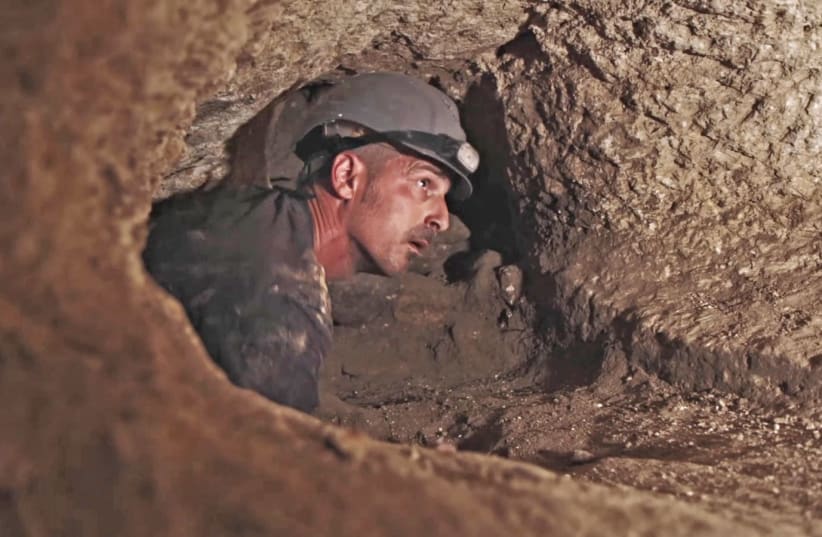The most extensive hiding complex discovered to date in the Galilee has been excavated in an archaeological excavation carried out by the Israel Antiquities Authority (IAA) at the site of Huqoq (Hukkok) – an ancient Jewish village 12.5 km. north of Tiberias.
The area is mentioned in the Book of Joshua (Joshua 19:34) and has been settled since ancient times. The dig uncovered finds that reveal dramatic episodes in the history of the Jewish people, including the preparation of shelters in preparation for the Revolt of the Jews against the Romans, led by Bar-Kochba in 132 to 136 CE.
The dig was carried with the help of hundreds of school pupils, university students, soldiers, and volunteers. The Heritage Ministry, the Israel Antiquities Authority, KKL-JNF, and the Zefat Academic College in Safed that funded the dig invite the public to open days to view the site on Friday, March 29, and Friday, April 5, between 8:00 and 13:00. Participation is free but requires registration at the IAA site at www.iaa.org.il.
The excavation also revealed that, as part of the preparations for the First Revolt in 66 CE and the Bar-Kochba Revolt in 132 CE, the residents of Huqoq converted the water cistern that had been dug during the Second Temple period into a hiding complex. In addition, at the time of danger, they broke one of the walls of the mikveh and dug a tunnel into other cavities.
Several tunnels allowed maneuvering in narrow, low spaces underneath the houses. In this underground system, which was the largest and most impressive discovered at the Galilee, there are about eight hiding cavities. The connecting tunnels are dug at 90-degree angles making it difficult for the heavily armed Roman soldiers to chase the rebels. The excavation also yielded hundreds of broken clay and glass dishes, an impressive ring for a precious stone (the stone itself was not found), and other fascinating finds.

A Jewish town dating back 2,000 years
Huqoq is known as a Jewish town from the Early Roman period, about 2,000 years ago. The Jerusalem Talmud and the Babylonian Talmud mention Rabbi Pinhas and Rabbi Hezekiah – sages from the third and fourth centuries CE who lived in the area. On the hilltop near the hiding complex, a synagogue with impressive and unique mosaics dating to the Byzantine period was discovered. The synagogue was dug since 2011 by an expedition from North Carolina University headed by Prof. Jodi Magness.
THE GOAL of the IAA’s archaeological excavation in Huqoq is to reveal the rich history of the site while involving the youth in its discovery and eventually making the site available to the public. The hiding complex system is one of the important sites that will be developed in the Galilee, revealing to the public the defense methods of the Jewish population at the time of the revolts.
“We turned the excavation in the hiding complex into a community excavation as part of the IAA’s vision of connecting the public to its heritage,” says Dr. Einat Ambar-Armon, director of the IAA’s Archeological-Educational Center in the northern region. “The excavation brings together school students studying the Land of Israel and Archaeology, students from the Zefat Academic College [in Safed], volunteers from the Israel Cavers Club, local volunteers, and even soldiers from the IDF Samur Unit of underground operations who use their skills for this important goal.”
“The hiding complex provides a glance on a tough period of the Jewish population in Huqoq and in the Galilee in general,” explained the excavation directors, the IAA’s Uri Berger and Prof. Yinon Shivtiel of the academic college. “However, the story that the site tells is also an optimistic story of an ancient Jewish town that managed to survive historical tribulations.” They added that “it is a story of residents who, even after losing their freedom, and after many hard years of revolts, came out of the hiding complex and established a thriving village, with one of the most impressive synagogues at the area.”
The discovery of the hiding complex can also contribute to a decades-long debate among researchers on whether the Bar-Kochba Revolt reached the Galilee or remained within the confines of Judea and central Israel.
Based on different findings, Berger and Shivtiel date the inner parts of the hiding complex to the days of the outbreak of the Second Revolt and consider that several of the ancient facilities were first in use during the First Revolt. “It is not certain that the complex was used for hiding and escaping during the Second Revolt, but it does appear to have been prepared for this purpose,” they say. “We hope future excavations will bring us closer to the answer.”
According to IAA director-general Eli Escuzido, “We view the Huqoq site and its various discoveries as part of a flagship project that will draw visitors from all over Israel and the world. Along with our partners, the site will be made accessible to the public.”
According to KKL-JNF northern region manager Shali Ben-Yishai, “In light of the finds in the excavation and the great potential of the Huqoq site, KKL-JNF is preparing a detailed program for the development of the site into a unique public spot of archaeological tourism in Israel and abroad. The Huqoq site is an example of collaboration between nature, tourism, and archaeology, with the participation of the IAA and the Jordan Valley Regional Council.”
